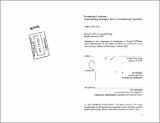| dc.contributor.advisor | Jan Wampler. | en_US |
| dc.contributor.author | Jonic, Andrew Peter, 1975- | en_US |
| dc.contributor.other | Massachusetts Institute of Technology. Dept. of Architecture. | en_US |
| dc.date.accessioned | 2011-12-09T21:19:57Z | |
| dc.date.available | 2011-12-09T21:19:57Z | |
| dc.date.copyright | 2001 | en_US |
| dc.date.issued | 2001 | en_US |
| dc.identifier.uri | http://hdl.handle.net/1721.1/67533 | |
| dc.description | Thesis (M.Arch.)--Massachusetts Institute of Technology, Dept. of Architecture, 2001. | en_US |
| dc.description | Includes bibliographical references (p. 104-105). | en_US |
| dc.description.abstract | Since the 1880's the United States government has been constructing buildings on national park land. The visitor and administrative building typologies in the National Park Service have evolved from Army barracks at Fort Yellowstone, to railroad hotels, to the Mission 66 visitor centers, and finally into the present-day interpretive center. Currently, two-dimensional representations within a visitor center, and park ranger interaction beyond, have typically been the devices with which the National Park Service educates the visiting public about a celebrated landscape. The intention of this thesis is to explore and re-think the design of the interpretive center through the three-dimensional use of architecture as the educational link between landscape and human understanding of it. The physical and mental comprehension of a landscape over the course of time is dependent upon the affects external stimuli have on the five senses. The ability of architecture to increase the stimulation of one sense would potentially trigger a memorable experience. Through the designed construction and placement of man-made and natural materials along a path, this thesis aims to generate visitor comprehension through the architecturally heightened experience of singular programmatic and landscape elements. Similar to two-dimensional subject matter, these landscape interventions are open to individual interpretation. | en_US |
| dc.description.statementofresponsibility | Andrew Peter Jonic. | en_US |
| dc.format.extent | 106 p. | en_US |
| dc.language.iso | eng | en_US |
| dc.publisher | Massachusetts Institute of Technology | en_US |
| dc.rights | M.I.T. theses are protected by
copyright. They may be viewed from this source for any purpose, but
reproduction or distribution in any format is prohibited without written
permission. See provided URL for inquiries about permission. | en_US |
| dc.rights.uri | http://dspace.mit.edu/handle/1721.1/7582 | en_US |
| dc.subject | Architecture. | en_US |
| dc.title | Interpreting landscape : understanding through a story of architectural experiences | en_US |
| dc.title.alternative | Understanding through a story of architectural experiences | en_US |
| dc.type | Thesis | en_US |
| dc.description.degree | M.Arch. | en_US |
| dc.contributor.department | Massachusetts Institute of Technology. Department of Architecture | |
| dc.identifier.oclc | 48086238 | en_US |
